- Soil compaction occurs when soil particles are pressed together by the passage of machinery and livestock
- Wet soils are most at risk, particularly clay soils. Avoid activities on the soil when it is wet
- Compaction leads to rough seedbeds, poor crop establishment, slow root growth, reduced water infiltration, reduced biological activity and reduced crop yields
- Prevention of compaction is better than cure
|
- Guidance systems can improve track layouts and reduce excessive compaction by farm machinery
- Controlled traffic can improve traction by reducing fuel usage, facilitating zero till systems, and separating traffic from cropping zones
- Bare soils are more prone to compaction than soils with good ground cover
- Repair compaction by planting "break crops" or deep rooted perennials or by a one-off deep ripping
|
Understanding the problem
|
| Why is it important to me as a farmer?
|
- Soil compaction refers to the compression of a soil into a hard mass after continuous passage of heavy machinery, implements or animals (particularly in wet conditions).
- Compaction can lead to soil structure decline
- 'soil structure' refers to the arrangement, size and shape and proportion of stable soil aggregates (or peds) in the soil profile
- The structure determines soil drainage, porosity, microbial activity, root penetration, aeration, availability of nutrients to plants, water-holding capacity and resistance to erosion and mass movement. Soil structure can be adversely affected by agricultural practises that either breakdown structure or cause soil compaction.
- The breakdown of soil structure is the cause of:
- restricted root growth, reducing the uptake of water and nutrients by plants
- lower average soil pore size, affecting the water-holding capacity of the soil and the activity levels of soil microorganisms
- reduced infiltration rates, increasing the likelihood of surface run-off, water erosion and surface ponding.
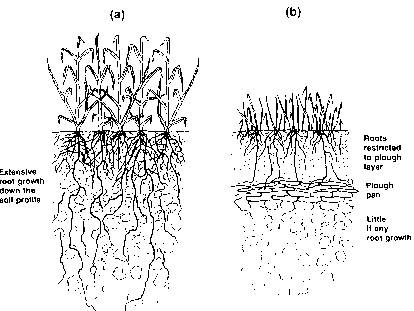 Figure 1 - No compaction versus hard pan due to compaction - Source Soil Types and Structures Module, DEPI Victoria - Source: DEPI Victoria
Figure 1 - No compaction versus hard pan due to compaction - Source Soil Types and Structures Module, DEPI Victoria - Source: DEPI Victoria
[View larger image]
|
- Compaction of surface and sub-surface soils threatens agricultural production as it degrades the productivity of most cropping soils. In addition, compaction caused by machinery can reduce the productivity of the land and increase run-off rates, which may increase the likelihood of water erosion and threaten water quality
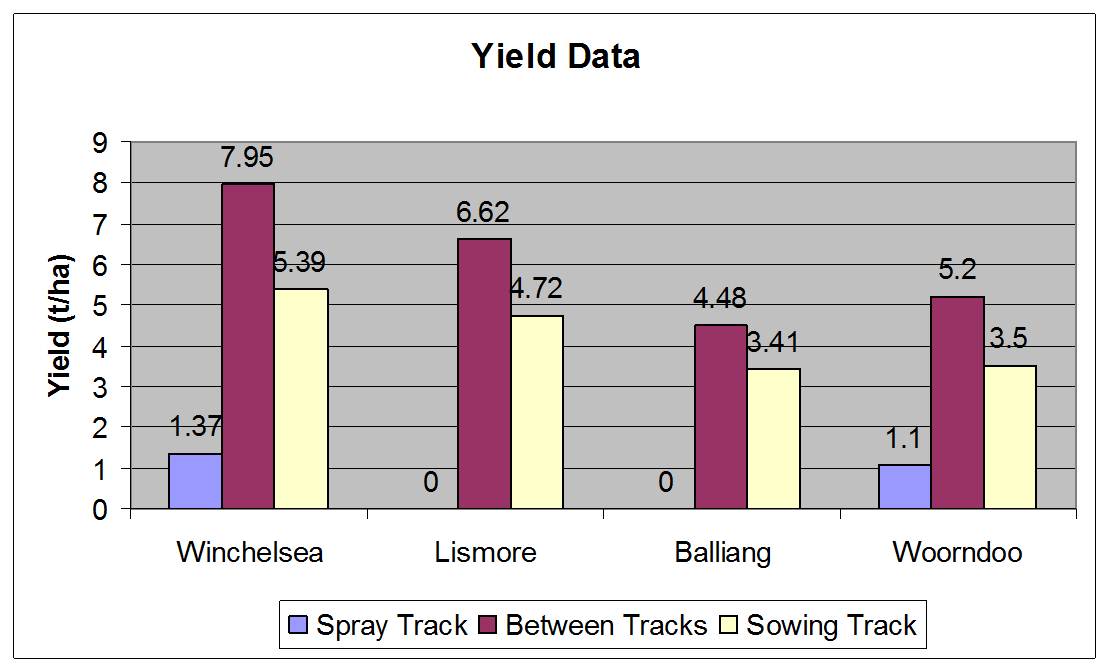
Figure 2 - Compaction by wheels and yield. 1 wheel pass at sowing = 30% yield reduction. Winchelsea: Wheat. Lismore and Balliang: Barley. Woorndoo: Lupins - Data for 2004 courtesy of Andrew Whitlock
[View larger image]
- In drier parts of the Corangamite region, compaction of the surface soil as a result of intensive treading of hard-hoofed animals also causes significant soil structure decline, particularly on fine sandy loam soils
- Pugging and hoof compaction significantly impact soil health and threaten agricultural productivity
|
- Soil compaction occurs when a pressure exerted by machinery tyres, tines or livestock compresses the soil increasing its density. Denser soil leads to reduced crop establishment, poor rainfall infiltration and lower crop yields, and can increase runoff and soil erosion.
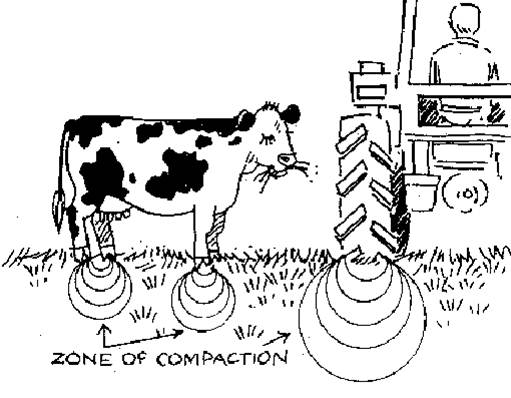
Figure 3 - Zone of compaction - Source: Soil Types and Structures Module, DEPI Victoria
[View larger image]
- Compaction occurs most often in moist or wet soil. In freshly cultivated soil, the first pass does the greatest damage usually in the top 20-30 cm of soil.
- In conventional tillage systems, most of the surface area of a paddock receives at least one wheel pass during a fallow, and even in zero tillage systems, the surface area is covered by wheel tracks from harvesters, sprayers and planting tines.
|
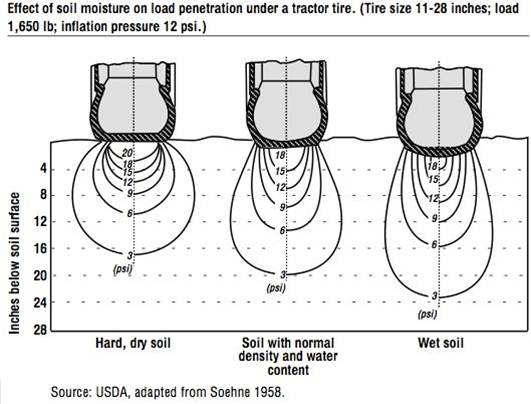
Figure 4 - Static pressure exerted on soil by a tractor tyre (kPa) - Source: USDA
[View larger image]
- Soils most vulnerable to soil structure decline are sandy loams, sandy clay loams, and sodic duplex soils. These soils in the cropping areas are particularly vulnerable as the soil is disturbed more frequently.
- Compaction and associated pugging and waterlogging are common in the higher rainfall pastures of the region, .particularly those on the clay soils of the Gellibrand Marl (Heytesbury) and Basalt.
For detailed information about regional soils, refer to Soils of the Corangamite
Region online
Figure 5 - Areas of high to very high soil structure decline susceptibility in the Corangamite region - Source: CCMA Soil Health Strategy
|
| How to recognise it in the paddock
|
- Bulk density is a measure of the degree of soil compaction
- Soil compaction is recognisable by poor plant growth, lack of organic matter and the presence of soil crusting
- A compacted soil will look like a dense layer or section of soil within the soil profile where the soil particles are packed close together, decreasing pore space and increasing bulk density. In a compacted soil the large pores that exist both around the aggregates and within the aggregates, are reduced.
- A compacted layer may look like a brick, as shown in the photograph below of Red Brown Sodosol with compaction just below the plough layer.
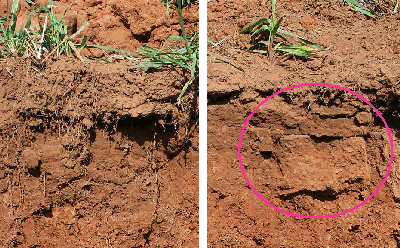
Figure 6 - Excessive wheeled traffic in moist conditions - This brick like unit in the upper subsoil (right image) is the result of excessive wheeled traffic in moist conditions. The left image is from the same soil pit but in an area that has not been subject to wheeled traffic and is less compacted - note the greater extent of soil aggregates and root distribution. The first pass of a vehicle over wet soil can cause 90% of the damage. Source: Daniells et al - SOILPak, (1994)
- Compaction is more likely in the subsoil. Dense subsoil can also have a "massive" (or featureless) appearance, a puggy feeling with peds breaking with force or tearing rather than along normal fracture lines.
- Associated symptoms include poor establishment adjacent to the wheel tracks, water ponding in tracks and headlands, distorted crop root systems ("right angle" disease), crop lodging and "thirsty" crops due to shallow rooting. Crops with thick taproots (e.g. safflower, lupins, canola) have a better ability to penetrate these compacted layers than those with fibrous roots (wheat, barley).
|
Methods to measure compaction
Use the 'NZ Visual Soil Assessment' guide to identify compacted layers and depth of rooting
- Digging with a shovel:
- Dig a 30-cm deep hole.
- As you dig you will be able to feel if there is a hard, compacted layer
- With your shovel, take a slice off one side of the hole, lift it out and lay it on its side.
- Compacted soil shows up as a hard solid layer with large, deformed aggregates. The soil above it is usually looser and separates quite easily to expose the smooth surface of the compacted section. The compacted soil is often arranged into horizontal layers, giving a platy structure. You may see plant roots growing horizontally along the top of the compacted layer because they cannot grow through it.
2. Measuring Surface Soil Strength:
- A penetrometer, preferably with a gauge, is pushed into the soil at a constant rate and readings observed as it moves down the soil profile
- Penetrometers are one of the most widely used methods of estimating resistance to root growth in soil, and is also useful detecting layers of different soil strength
- Colour coding on gauged penetrometers (green, yellow and red) provides a broad indication of restrictions to root growth
- Is a useful tool to demonstrate impact of management practices on soil compaction e.g. hard pans, high traffic areas etc. and to get a visual reference
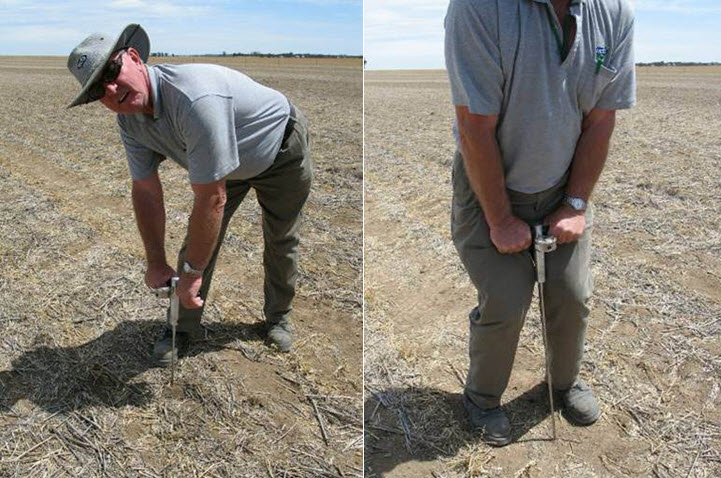
Figure 7 - No wheel tracks (left) versus Wheel tracks (right) Source: Better Soils SA website
[View larger image]
|
| What is the best practice?
|
- Preventing soil compaction
- Repairing compacted soils
- Maintaining soil structure
|
| How can you achieve this?
|
1. Preventing soil compaction
Controlled trafficking of machinery and raised beds (cropping)
Through the adoption of bed farming (raised beds or controlled traffic flat beds as appropriate) to reduce soil compaction and improve soil structure - which currently cover about 10% of the annual crop area in the Corangamite region.
- Raised beds aim to reduce machinery compaction by lifting the soil above the saturated zone. Where used, raised beds have significantly improved soil structure and reduced waterlogging on cropping land, while significantly increasing agricultural productivity in high rainfall areas
- Controlled traffic flat beds:
- Minimises the forces applied to soil from tillage and traffic
- This can be achieved by limiting trafficking by agricultural machinery to designated areas, rather than across a whole paddock. Traffic is confined to the least amount of permanent wheel tracks possible- limiting compaction to zones, whilst the rest of the seedbed remains undisturbed. This system is known as controlled traffic farming (CTF):
- The decision to adopt controlled traffic farming (CTF) can a difficult one as it generally involves a significant capital outlay and small reduction in total cropping area
- The best way to implement CTF is to develop a unique system that fits the landholders own farm and circumstances. For example, contour seeding can utilise a single marker arm with matching machinery widths and wheels tracks, whilst paddocks can also be worked up and back (again with matching machinery widths and wheel tracks) utilising auto-steer where available and considering options such as raised beds on low country. It is the right system for the landholder if it fits their economic conditions and farming style
- An added benefit of CTF if removing subsurface or seedbed compaction through deep ripping, is that soil will continue to remain loose and friable for many years after natural 'settling' as soil is not being trafficked back to its original compacted state
|
- General points to note:
- Regardless of how you manage your cultivation, some damage will occur. If high tyre pressures have to be used, use tall narrow tyres in preference to small wide tyres or duals. When trucks and field bins are used at harvest, confine travel to one area and do not drive all over the paddock
- The optimum soil conditions for crop production (soft, friable, permeable soil) are quite unsuitable for efficient traffic operation, and vice versa
- Track layers have the advantage of compacting considerably less area for the same amount of power. Dual and radial tyres do not reduce compaction when used at the same tyre pressures as single or conventional tyres. Wheel slip does not increase soil compaction unless it is greater than 15%. Compaction risk is greatest during wet harvests
Stubble retention (cropping) and maintain good groundcover (grazing)
- Increasing SOM content can lead to a decrease in soil bulk density, and helps keep soil particles apart - reducing the potential effects of trafficking on soil compaction and stabilising soil. The 'living' organic fraction (soil fungi, bacteria and plant roots) also help stabilise soil aggregates
- A good pasture cover helps cushion the effect of cattle hooves on soil. Compaction is more severe when the soil is bare and the pasture is sparse
Improved stock control and vehicle movement when wet (grazing/dairy)
- It is best to keep cattle off the wetter paddocks in the wet season, and move them to higher grounds during wet periods
- Keep vehicles and farm machinery off wet paddocks. In addition to causing compaction, the resultant wheel ruts can lead to erosion
- Loafing pads and feeding pads or sacrifice paddocks are useful in dairy situations, to enable cows to be held and fed during periods of wet weather
- Install laneways. By confining cattle traffic to laneways, soil compaction and pugging is minimised. This helps to keep the rest of the paddock'sall weather area in a good condition for growing productive pastures. Cement or stabilised earth laneways are desirable, especially near the dairy
Place fences strategically / land class fencing (grazing)
- It is easier to keep stock off wet areas if the paddock fences are located so that they separate the drier locations and soils from the wetter flat locations
- Consider land class fencing as a component of Whole Farm Planning
|
2. Repairing compacted soils
Grow deep-rooted perennial pastures (grazing) and 'primer' crops (cropping)
- Sowing deep rooted perennial grasses will help break up compacted soil layers. The fibrous root systems penetrate compacted soil and the addition of organic matter from litter and roots helps to restructure the degraded soil
- Tap-rooted plants such as lucerne, lupins and chicory are able to 'drill' through compacted layers and are often called 'primer crops'
Deep rip the paddocks (cropping & grazing)
- Deep ripping the paddocks with a suitable tyned implement either once-off, or every 10 years or so, or when necessary, helps to break up compacted layers in the soil and allow the roots, water and air to again move unrestricted through the soil
- Success depends on moisture content at ripping, sodicity, severity of compaction or plough-pan. If there is no compacted layer, there is no need to rip. Gypsum should also be applied for sodic and dispersive soils
- It is recommended that if the soil is identified as heavily compacted, that deep ripping should be considered before you introduce techniques such as minimum tillage and direct drill, otherwise these techniques are unlikely to be successful by themselves
Introduction of deep burrowing earth worms and dung beetles (grazing-dairy)
- The introduction of tunnelling dung beetles and earthworms improve the soil structure by increasing the large pores in the soil, by mixing the soil, and by incorporating organic matter into the soil
- Earthworm numbers can be increased by increasing the amount of organic matter in the soil, keeping the soil pH above 5.0 and minimising soil disturbance. Dung beetles can be introduced into paddocks where their numbers are low
3. Maintaining soil structure
Prevent soil compaction - by adopting the practices outlined above
Maintain a dense pasture cover (grazing)
- The root systems of healthy pastures and crops add organic matter to the soil. Growing well managed pastures is the cheapest and most effective way of maintaining good soil structure
- Overgrazing caused by over stocking can reduce the pasture'sability to provide this input of valuable organic matter to the soil
- On/off grazing. In Victoria, the use of on/off grazing has shown to dramatically reduce the severity of pugging and compaction. This usually involves grazing pastures for two to fours hours and then removing the cows before severe pugging damage starts to occur. Cows are removed to 'stand-off' areas and fed supplements
|
3. Maintaining soil structure (continued)
Minimise tillage
- Wherever possible, sow pastures and crops by direct drilling. Direct drill sowing helps to maintain soil structure by minimising the amount of soil disturbance
Cultivate the soil only when the moisture content is right!
- A simple test called the 'rod' or 'worm' test will help you avoid compacting the soil. Rapidly squeeze a small lump of soil into a ball and try to roll it into a 50mm long rod about 3-4mm in diameter. If you can make a rod easily, the soil is too wet and will compact if it is worked or has animals or machinery on it. If you can just make a crumbly rod the water content should allow traffic and cultivation without compaction. If you can't make a rod at all, the soil could be too dry for tillage in a sandy or loamy soil. You need to do this test at several points over the full depth of any proposed cultivation
Figure 8. The 'worm' test for suitability to cultivate Source: DEPI Victoria.
Improve drainage
- If waterlogging is a problem, consider surface and/or subsurface drainage to remove excess water from the soil profile
- Drainage of the soil will reduce the susceptibility to pugging and compaction and improve production in wet periods
- It is recognised that the proper installation and maintenance of surface drainage (including raised beds) is critical in minimising off-site impacts, especially where sediments and nutrients may enter waterways and threaten water quality
|
Other related questions in the Brown Book
|
|
Brown Book content has been based on published information listed in the Resources and References sections below
|
- Compaction- Victorian Resources Online - Department of Environment and Primary Industries - Victoria
- Soil Compaction - Soil Health Knowledge Bank - Department of Agriculture, Fisheries and Forestry
- Protect your soil from compaction - Soil Health and Fertility - Department of Primary
Industries - New South Wales
|
|
- Dahlhaus, P.(2005) Evaluating the public benefit from the soil health actions. Discussion paper for Corangamite Soil Health Strategy 2006-2012. Dahlhaus Environmental Geology.
- Clarkson T, Department of Primary Industries on behalf of the Corangamite Catchment Management Authority (2007). Corangamite Soil Health Strategy 2007. Corangamite Catchment Management Authority, Colac, Victoria.
- FarmPlan21 Manual, Develop a Whole Farm Plan. Department of Primary Industries, Farm Services Victoria, June 2010
- Compaction. Victorian Resources Online. Victoria Department of Primary Industries
|
- Rebecca Lines-Kelly (2004) Protect your soil from compaction. NSW Department of Primary Industries
- Controlled Traffic Farming - Fact sheet for Soil Quality - Soilquality.org.au
- Subsurface Compaction - Fact sheet for Soil Quality - Soilquality.org.au
- Department of Primary Industries (2011), Soil Types and Structures Module. Victorian Department of Primary Industries
- MacEwan R. (2003). Soil Health Strategy for Corangamite Region (Discussion paper). Centre for Land Protection Research
|
|